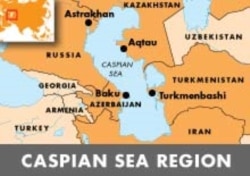Threats ranging from hunting to pollution are behind the species' decline to just 10 percent of its numbers of a century ago. But conservation efforts might provide hope for these spotted mammals.
Officials in Kazakhstan now say 363 dead seals have been found on the Caspian Sea coast of the Mangystau region.
The number of reported dead seals in the area has been growing daily since the first carcasses were found between the Kalamkas and Karazhanbas oil deposits -- most of them pups.
Kazakhstan's Environment Ministry says preliminary data suggests that abnormally warm temperatures prevented the formation of ice sheets in the northeastern Caspian. Ice floes allow newborns time to gain strength before they must take to the water.
The ministry says it will issue final conclusions once carcass and seawater analyses are complete.
Lack Of Ice
The Caspian seal is the Caspian's lone mammal species, and can be found nowhere else in the world. Among the smallest of the "true seals," most Caspian seals inhabit the southern Caspian from May to September. In the fall, they migrate northward to ice sheets to bear pups and breed.
Gulshan Huseynova, a spokeswoman for Azerbaijan's Ecology Ministry, tells RFE/RL that the "ice theory" would explain why most of the dead seals are just pups.
"Seals usually are very sensitive in January, February, and March, because it's their breeding period. They usually turn to northern Caspian waters in this period -- Russia and Kazakhstan. In Azerbaijan [this year], though, we haven't monitored any dead seal yet."
Massive deaths occur on an almost annual basis in the Caspian region. A year ago, hundreds of dead sturgeon and seals washed ashore near the Kalamkas oil field.
...Or Other Threats?
Mels Eleusizov, who heads Kazakhstan's environmentalist Tabigat (Nature) party, criticizes the oil industry and suggests it might be to blame for some of the environmental havoc.
"It used to be a nature reserve, [but] now everything is under the control [of oil companies]," Eleusizov says. "They do whatever they want. They don't care about anything except getting more oil, getting more profits."
The northern part of the Kazakh section of the Caspian Sea was a nature reserve until the 1990s, when Kazakhstan began exploring the region for hydrocarbons.
Amantay Suyesinov, chief of the oil industry department at Kazakhstan's Energy Ministry, told RFE/RL that it was too early to say whether a poisonous substance from the oil production process might have played a role in the seals' deaths.
"Everybody blames oil production companies," Suyesinov said. "Well, I cannot say that they're not guilty, but we need proof. So far, nobody has proved that the seals died as a result of [oil-drilling] operations. Nobody has said specifically, 'This company spilled oil; and because of that, these animals died.'"
Precipitous Decline
Simon Goodman, a biology professor at the University of Leeds who coordinates a project on conservation issues and threats facing Caspian seals, tells RFE/RL that disease, pollution, hunting, falling numbers of fish, and fishing bycatch (the killing of animals incidental to the catching of other species) are believed to have driven the number of the Caspian seals to around 100,000. Global warming is also believed to be contributing to the decline. The seals were believed to total more than 400,000 in the 1980s -- and 1 million 100 years ago.
Goodman says a viral epidemic was the primary factor in the biggest reported mass death of Caspian seals in years, involving more than 10,000 individuals.
"Canine distemper virus -- that's a disease of dogs and other carnivores," And it's thought that, occasionally, the virus is transferred into the seal population."
Goodman says there is no evidence to suggest that direct pollution from the oil industry affects the seal populations.
But he notes that pollutants accumulate in seals, weakening their immune systems and causing infertility. Such pollutants originate in heavy industry and enter the Caspian Sea via rivers.
Goodman says most of that pollution arrived during the Soviet era, but it takes a long time to disappear. He says the release of such chemicals is now much more tightly controlled.
Goodman says a lot is being done to protect the species under the Caspian Environment Program, a project established by the five Caspian littoral states -- Azerbaijan, Iran, Kazakhstan, Russia, and Turkmenistan -- and supported by international organizations.
"The aim of [the Caspian Environment Program] is to control a whole range of conservation and environmental protection plans for the whole Caspian ecosystem," Goodman says. "So there are separate plans for different components of the Caspian ecosystems. One of the plans which is being developed is a conservation action plan for Caspian seals. That involves input from stakeholders in all of the Caspian countries as well as advise from international scientists."
Goodman says the Seal Conservation and Management Action Plan is expected to be finalized in the coming months.
The scheme would set voluntary guidelines for littoral states to help them develop their own conservation goals. These include creating protected zones in breeding areas and steps to make hunting and fishing sustainable. It would also promote scientific cooperation among the states that share Caspian coastline.
(RFE/RL's Kazakh and Azerbaijani Services contributed to this report.)
The Post-Soviet Environment
 The skull of a male saiga antelope in Kalmykia. Saiga numbers have collapsed disastrously over the last decade. (shpilenok.com)
The skull of a male saiga antelope in Kalmykia. Saiga numbers have collapsed disastrously over the last decade. (shpilenok.com)
THE FRAGILE PLANET: Since the collapse of the Soviet Union, old environmental disasters have come to light and new ones have emerged. War, poverty, and weak central-government control have led to serious environmental problems from Eastern Europe to the Russian Far East. RFE/RL has provided extensive coverage of these important issues and of efforts to cope with them.
RELATED ARTICLES
Saiga Antelope's Saga Attracts New Allies
Project To Reverse Aral Sea Damage Making Progress
Iraqi Marshes Show Signs Of Strong Recovery
Deforestation Rampant In South And Central Asia
Environmentalist Says BTC Pipeline Could Be 'Death Of Caspian'
Scientists Raise Alarm As Man-Made Deserts Spread
Nature Waits For Cross-Border Sanctuaries To Catch On
Central Asian Vllagers Encouraged To Protect Snow Leopards
Environmentalists Raise Concerns About Russian Ecology Policy















